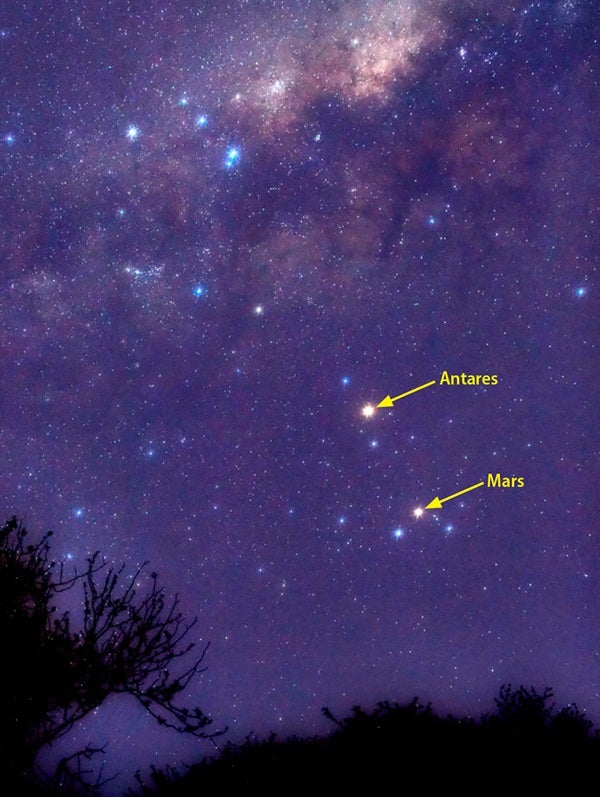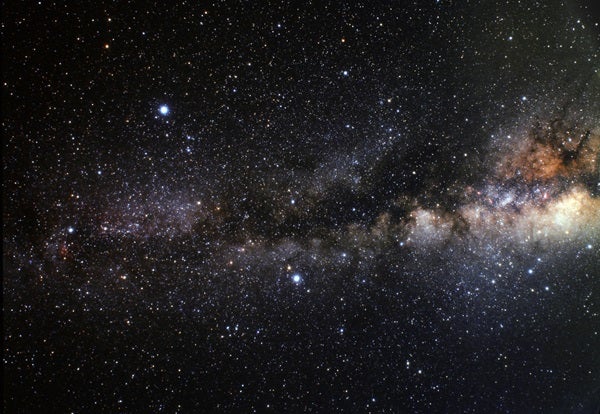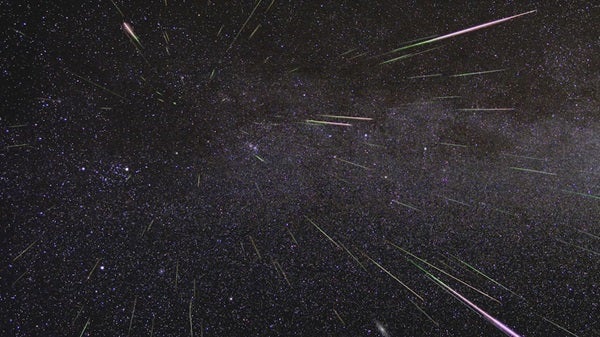If you’re game for a quick evening challenge, try to spot Neptune through binoculars. The distant planet lies halfway to the zenith in the southern sky near the end of evening twilight and doesn’t set until 11 p.m. local time. The magnitude 7.9 world appears against the backdrop of Aquarius, 0.6° south of the 4th-magnitude star Lambda (λ) Aquarii. You’ll need binoculars to spy Neptune and a telescope to see its blue-gray disk, which spans 2.3″.
Saturday, December 9
A lone bright star now hangs low in the south during early evening. First-magnitude Fomalhaut — often called “the Solitary One” — belongs to the constellation Piscis Austrinus the Southern Fish. From mid-northern latitudes, it climbs 20° above the horizon at its best. How solitary is Fomalhaut? The nearest 1st-magnitude star to it, Achernar at the southern end of Eridanus the River, lies some 40° away.
Sunday, December 10
Last Quarter Moon occurs at 2:51 a.m. EST. It poked above the eastern horizon shortly before midnight local time yesterday evening and climbs highest in the south as twilight starts to paint this morning’s sky. The half-lit Moon spends the morning hours in the southern part of the constellation Leo the Lion.
Monday, December 11
The second-brightest asteroid of 2017 puts on a nice show during December. Minor planet 7 Iris rides high in the evening sky among the background stars of Aries the Ram. It glows at 8th magnitude and should be relatively easy to spot through binoculars even from the suburbs. This evening, you can locate Iris about 2° south-southwest of the 5th-magnitude star Iota (ι) Arietis.
Although the calendar says December, the Summer Triangle of bright stars remains prominent during the early evening. Look for this large asterism in the western sky after darkness falls. Approximately one-third of the way to the zenith lies the Triangle’s brightest member, magnitude 0.0 Vega in the constellation Lyra. Magnitude 1.3 Deneb in Cygnus stands about 25° above Vega. And 35° to Vega’s left lies magnitude 0.8 Altair in Aquila. Altair sets shortly before 9 p.m. local time, destroying the geometric pattern.
Mercury reaches inferior conjunction, passing between the Sun and Earth, at 9 p.m. EST. The fast-moving innermost planet will return to view before dawn next week.
Wednesday, December 13
The waning crescent Moon points the way to Mars this morning. Earth’s only natural satellite appears 5° above Mars in the southeastern predawn sky, while Jupiter appears 11° below its sister planet. Of course, the Red Planet stands out on mornings all this week. The magnitude 1.6 world rises four hours before the Sun and appears 25° high as twilight starts to paint the sky. It resides among the background stars of Virgo, about 10° to the lower left of the Maiden’s brightest star, 1st-magnitude Spica. Notice the color contrast between the orange-red planet and the blue-white star. Unfortunately, the view through a telescope proves disappointing — Mars spans just 4″ and shows no detail.
Thursday, December 14
A day after its close approach to Mars, the waning crescent Moon hangs near Jupiter. Our satellite’s 12-percent-lit crescent appears 5° to Jupiter’s upper left. The giant planet shines at magnitude –1.7 and is the brightest point of light in the night sky. Look for it any morning this week — it rises three hours before the Sun and climbs 20° high an hour before sunup. A telescope reveals the planet’s 32″-diameter disk.
The Geminid meteor shower peaks this morning under nearly ideal conditions. The waning crescent Moon near Jupiter doesn’t rise until 3:30 a.m., and even after that if sheds little light. Observers under a clear dark sky can expect to see up to 120 meteors per hour — an average of two per minute. The meteors appear to radiate from a spot just north of Castor, the bright star in the northern part of the constellation Gemini the Twins. This region passes nearly overhead from mid-northern latitudes around 2 a.m. local time, although conditions remain excellent from mid-evening yesterday until morning twilight commences.
Uranus reached opposition nearly two months ago, but it remains a tempting target. The outer planet climbs highest in the south around 8 p.m. local time, when it appears two-thirds of the way to the zenith. The magnitude 5.7 world lies in southeastern Pisces, 3.5° west of the 4th-magnitude star Omicron (ο) Piscium. Although Uranus shines brightly enough to glimpse with the naked eye under a dark sky, binoculars make the task much easier. A telescope reveals the planet’s blue-green disk, which spans 3.6″.
Saturday, December 16
Head outside in early evening this week and you can see the Big Dipper scraping the northern horizon. For latitudes north of about 40°, this conspicuous asterism never sets (“circumpolar” in astronomical parlance), though December evenings find it at its lowest ebb. This means that the constellation on the opposite side of the North Celestial Pole, the familiar W-shaped Cassiopeia, currently rides highest in the sky.
Sunday, December 17
The variable star Algol in Perseus appears faintest at 2:22 a.m. EST tomorrow morning, when it shines at magnitude 3.4. Observers across North America should start watching it after darkness falls tonight if they want to witness its dramatic drop from peak brightness (magnitude 2.1). This eclipsing binary star runs through a cycle from minimum to maximum and back every 2.87 days, but the drop from peak brightness and subsequent rise lasts only about 10 hours. Algol appears in the east-northeast after sunset and passes nearly overhead around 9:30 p.m. local time.












